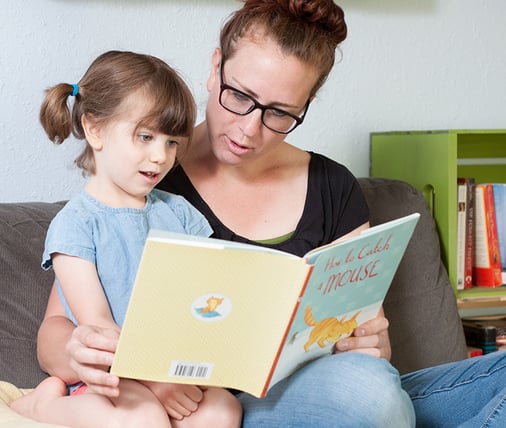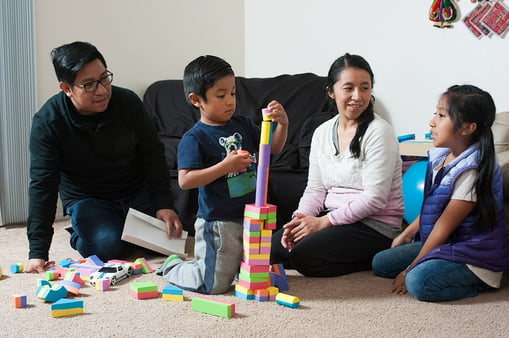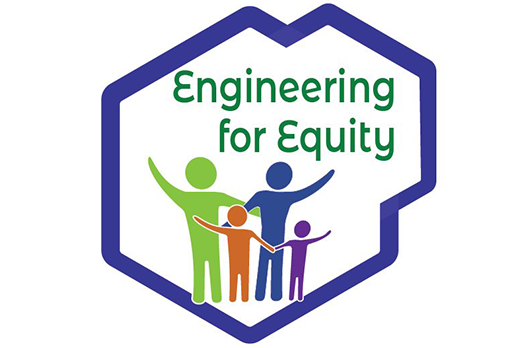TERC Blog
Part 3 - Engineering for Equity: Family Collaboration, post 2
Rethinking Our Approach to Collaborating with Families to Study and Support Engineering Learning
With my other children, I would just let them play. But these activities let me participate. Playing with him, I can see the strategies he’s using, his strengths and weaknesses. The activities also bring out his imagination … I’ve learned to participate with him, and to see his strengths and weaknesses.
— program participant
Welcome back to the Engineering for Equity blog series. In today’s post, we continue reflecting on our assumptions about families, our approaches to family research, and the ways we support engineering learning for both children and parents. In the last post, we shared thoughts on family learning more broadly. Today, we think more about the implications of these ideas specifically for engineering education research.
Although the ideas shared in our last reflection about families are not specific to engineering or STEM, we believe they have profound implications for how we think about and conduct our work as engineering educators and researchers. And this in turn is critical for supporting a more equitable vision of engineering education. These ideas have received new attention recently in scholarship connecting engineering and equity (Ata-Aktürk & Demircan, 2020; McWayne et al., 2018; Pattison et al., 2020). To organize our own thinking, we have begun to consider how these new perspectives on families impact the way we think about three aspects of our work: (a) where engineering learning and engagement happen, (b) what we mean by engineering, and (c) how we work with families to support this learning and engagement.
Where do engineering learning and engagement happen?
Once we take seriously the role of families in children’s education and learning, it quickly becomes clear that engineering and STEM learning more broadly are already happening every day in children’s homes and in their interactions with parents and other family members. Instead of asking “how we can get families engaged with STEM,” we begin with the question: “How are families already engaged?” (see Mejia et al., 2018; Vossoughi et al., 2016)

Decades of research have documented the rich ways that families engage with science and mathematics at home and in other informal learning settings (Callanan et al., 2013; Marin & Bang, 2018; NRC, 2009; Pattison et al., 2017; Silander et al., 2018; Strickler-Eppard et al., 2019). Emerging research is also describing how families engage with engineering in a variety of ways. For example, researchers have documented how young children’s play with simple materials like blocks creates opportunities for engaging with the engineering design process and using engineering thinking skills (Gold et al., 2020; Schmitt et al., 2018). In our work, we have seen that as families develop a broader sense of what engineering is—more than building bridges but a process for solving problems—they begin to connect it with many of the things they are doing every day, from fixing a broken piece of furniture to planning the morning routine for getting their children to school (Pattison et al., 2020). As one parent told us in a recent conversation:
I never thought about it, being an engineering, solving little problems like that. That's just what you do every day. Just what you have to do to solve the problem. But I guess that's engineering.
— program participant
Not only are children and their families engaging with engineering at home, but they have a wealth of existing knowledge and expertise to bring to these experiences (Calabrese Barton et al., 2021; Mejia et al., 2018; Rosebery et al., 2016; Wilson-Lopez et al., 2016; Yosso, 2005). As we discuss more in our future reflections on asset-based perspectives on engineering learning, this may be especially true for low-income families and the Latinx and Hispanic communities we work with through the Head Start on Engineering project. For these families, resourcefulness and everyday problem-solving are an essential part of life and a valued skill they hope to share with their children.
What do we mean by engineering?
Acknowledging that families already engage in engineering at home using their own engineering-related knowledge and experience forces us to rethink what we mean by engineering—and perhaps more importantly, who decides what counts as engineering and what does not (Mejia et al., 2018; Philip et al., 2018, p. 2018; Tan et al., 2018). As many scholars have argued, although the process of engineering is deeply rooted in the resourceful creativity, problem-solving, and inventiveness practiced by humans across time and cultures, the modern concept of engineering has largely been co-opted as the field became codified through professional organizations and university training programs (McGowan & Bell, 2020). This modern conceptualization has propagated a relatively narrow understanding of engineering and its role in society, ignoring the existing engineering knowledge and skills within communities outside the academic sphere and whitewashing the troubled history of the field in supporting the exploitation and repression of marginalized communities (Holly, 2020; Mejia et al., 2018; Vossoughi et al., 2016). And although calls have been made to shift how engineering is described (e.g., NAE, 2008), the fundamental ideas of the discipline have been transferred with very little critique to the broader K-12 education system (Cunningham & Lachapelle, 2014; McGowan & Bell, 2020).
If these ideas are problematic yet so pervasive, what are alternative approaches to defining engineering? This is a challenging topic that we will take up in more detail in future posts. But our recognition that families already practice engineering in their daily lives provides some insights. For most families that we have worked with, parents and caregivers begin with a relatively narrow definition of the word “engineering,” often focusing on the physical creations that some engineers build (e.g., bridges) or the skills that they see as being required to become an engineer (e.g., math). However, after learning more about the engineering design process and seeing a variety of examples of engineering in different contexts, many families come to develop a broad and empowering understanding of engineering—a problem-solving process that we all use every day to overcome challenges, big or small. Many parents and caregivers also come to identify engineering as synonymous with the problem-solving skills they are helping their children develop and that they see as critical for their children’s success.
How do we work with families to support engineering learning and engagement?
Recognizing that families already practice engineering and that these everyday engineering processes provide new insights into how we conceptualize the discipline leads us finally to think about the ways we work with families through our engineering education studies and programs. Again, the history of this relationship in engineering and STEM education research is fraught (Bevan et al., 2018; McGowan & Bell, 2020; Vossoughi et al., 2016). Even efforts that are ostensibly aimed at supporting equity often focus on surface-level goals, such as providing more access to existing programs and resources, rather than fundamentally rethinking the roles and relationships within the STEM education systems (Bevan et al., 2018; McGowan & Bell, 2020; Mejia et al., 2018; Philip et al., 2018).
One of the hardest truths for us as researchers to accept, we believe, is the immense amount of power and privilege many of us carry relative to the communities and families we work with (Garibay et al., 2017; Ladson-Billings & Tate, 1995; Tolbert et al., 2018). But if we acknowledge the ways that families are already engaging in STEM at home and the deep expertise and knowledge families bring to these experiences, then we must also accept that families are experts in their own right in the study of engineering education and learning. This acceptance leads us to a new vision in which researchers position themselves as learners and collaborators with parents (Civil et al., 2005), building long-term and reciprocal relationships with families (Tolbert et al., 2018) and using community-based and participatory approaches to research (Bang et al., 2016; Curry-Stevens et al., 2014; Holly, 2020; Meyer et al., 2021; Tolbert et al., 2018; Weiner & McDonald, 2013). As challenging as it is, we must find ways to share power when deciding what counts as engineering, what the goals of engineering education are, what the best approaches are to supporting engineering learning for families and children, and how success is measured. This also requires us to think critically about how we support the multiple roles that parents and other significant adults play in the family as learners, teachers, and advocates (Civil et al., 2005; Quintos et al., 2019) and an integral part of the broader family system (Broderick, 1993; Pattison et al., 2020)
One inspiring example of this type of work comes from Christine McWayne at Tufts University (McWayne et al., 2013, 2018, 2020, 2021). McWayne and her colleagues argue forcefully that we must move beyond traditional assumptions about “family engagement” with schools and develop models that equalize the power dynamics between parents and teachers and acknowledge the multiple ways that parents support their children’s learning (McWayne et al., 2021; McWayne et al., 2018). Through their work in partnership with Head Start, they explored opportunities such as collaborative development teams with both teachers and parents, multiple methods for parents and families to share their knowledge and experience with teachers that do not require English fluency or attending school-based events, and opportunities for parents to connect with each other to develop community. The group argued that these strategies not only helped redefine parent engagement and school-family relationships but also supported teachers in “building culturally relevant curriculum grounded in children’s everyday lives.” We agree that these strategies are promising, and we see more opportunities to develop family-school partnerships that not only inform classroom curriculum but also highlight the importance of family-based learning and the critical role of parents as their children’s first teacher (Bang et al., 2016).
Rethinking how we work with families has also motivated us to reflect on an even more fundamental question: Who benefits from our work? As we noted in our introduction to this blog series, we believe that although our work over the last decade has been with low-income English- and Spanish-speaking communities, who have long been underrepresented in STEM education and fields, much of the direct benefits of our projects have flowed back to us as researchers—including the money we receive from our grants, the recognition that comes from publishing and dissemination, and the social and political capital we accrue through our work as professionals. Several engineering education scholars recently reflected on a similar tension after attending a professional conference where workers at the conference center were on strike (Major, 2020; Riley et al., 2020): What are “ways we, as a community, can begin to “show up” to address systematic inequalities in our engineering education practices and participation” (Major, 2020, p. 166). We don’t have a simple answer to this question, but it’s an issue that we plan to center in our future work moving forward, thinking about the ways that we leverage our engineering education research to support the goals of the families we work with, elevate and empower the voices of family members, and help address fundamental systems of inequity in STEM education.
Navigate to other blog posts in this series here:
- Introduction - Engineering for Equity
- Family Collaboration, post 1
- Family collaboration, post 2
- Applying Asset-based Approaches
- Engineering and Executive Function Skills, post 1
- Engineering and Executive Function Skills, post 2
- Engaging Families with Engineering, post 1
About the Authors
Scott Pattison, PhD, is a Research Scientist at TERC. He has been studying and supporting STEM education and learning since 2003, as an educator, program and exhibit developer, evaluator, and researcher. His current work focuses on engagement, learning, and interest and identity development in free-choice and out-of-school environments, including museums, community-based organizations, and everyday settings. He has led numerous informal STEM education research projects and initiatives, including Head Start on Engineering, Storybook STEM, Math in Making, and REVEAL.
Smirla Ramos Montañez, PhD, is a bilingual (Spanish/English) and bicultural (Puerto Rican/American) Family STEM Learning Researcher at TERC. She has led and supported a variety of projects, including program and exhibit evaluation as well as STEM education research designed to provide accessible, culturally relevant, and engaging experiences for diverse audiences. Currently, she is the PI of the NSF-funded Diálogos project, which will engage parents as research partners to explore how informal family engineering activities can be leveraged to support the development of executive function skills for preschool-age children from Latinx families.
References Cited
Ata-Aktürk, A., & Demircan, H. Ö. (2020). Supporting preschool children’s STEM learning with parent-involved early engineering education. Early Childhood Education Journal. https://doi.org/10.1007/s10643-020-01100-1
Bang, M., Faber, L., Gurneau, J., Marin, A., & Soto, C. (2016). Community-based design research: Learning across generations and strategic transformations of institutional relations toward axiological innovations. Mind, Culture, and Activity, 23(1), 28–41. https://doi.org/10.1080/10749039.2015.1087572
Bevan, B., Calabrese Barton, A., & Garibay, C. (2018). Broadening perspectives on broadening participation in STEM: Critical perspectives on the role of science engagement. Center for Advancement of Informal Science Education. https://www.informalscience.org/sites/default/files/BP-Report.pdf
Broderick, C. B. (1993). Understanding family process: Basics of family systems theory. Sage Publications.
Calabrese Barton, A. M., Schenkel, K., & Tan, E. (2021). The ingenuity of everyday practice: A framework for justice-centered identity work in engineering in the middle grades. Journal of Pre-College Engineering Education Research (J-PEER), 11(1). https://doi.org/10.7771/2157-9288.1278
Callanan, M. A., Luce, M. R., Triona, L., Rigney, J. C., Siegel, D. R., & Jipson, J. L. (2013). What counts as science in everyday and family interactions. In B. Bevan, P. Bell, R. Stevens, & A. Razfar (Eds.), LOST opportunities: Learning in out-of-school time (pp. 29–49). Springer.
Civil, M., Bratton, J., & Quintos, B. (2005). Parents and mathematics education in a Latino community: Redefining parental participation. Multicultural Education, 13(2), 60–64.
Cunningham, C. M., & Lachapelle, C. P. (2014). Designing engineering experiences for all students. In Ş. Purzer, J. Strobel, & M. E. Cardella (Eds.), Engineering in pre-college settings: Synthesizing research, policy, and practices (pp. 117–140). Purdue University Press. https://doi.org/10.2307/j.ctt6wq7bh
Curry-Stevens, A., Reyes, M.-E., & Coalition of Communities of Color. (2014). Protocol for culturally responsive organizations. Center to Advance Racial Equity, Portland State University. https://www.oregon.gov/ohcs/OSHC/docs/HSC-2016/030416_HSC_LIFT_CARE-report.pdf
Garibay, C., Lannes, P., & González, J. (2017). Latino audiences: Embracing complexity. https://www.informalscience.org/latino-audiences-embracing-complexity
Gold, Z. S., Elicker, J., Kellerman, A. M., Christ, S., Mishra, A. A., & Howe, N. (2020). Engineering play, mathematics, and spatial skills in children with and without Disabilities. Early Education and Development, 1–17. https://doi.org/10.1080/10409289.2019.1709382
Holly, J. (2020). Disentangling engineering education research’s anti‐Blackness. Journal of Engineering Education, 109(4), 629–635. https://doi.org/10.1002/jee.20364
Ladson-Billings, G., & Tate, W. F. (1995). Toward a critical race theory of education. Teachers College Record, 97(1), 47–68. https://doi.org/10.1080/10282580701850413
Major, J. C. (2020). To cross the picket line or join it: Facing engineering education’s role in the socioeconomic exploitation of marginalized peoples to further a discipline. Journal of Engineering Education, 109(2), 164–169. https://doi.org/10.1002/jee.20313
Marin, A., & Bang, M. (2018). “Look it, this is how you know:” Family forest walks as a context for knowledge-building about the natural world. Cognition and Instruction, 36(2), 89–118. https://doi.org/10.1080/07370008.2018.1429443
McGowan, V. C., & Bell, P. (2020). Engineering education as the development of critical sociotechnical literacy. Science & Education, 29(4), 981–1005. https://doi.org/10.1007/s11191-020-00151-5
McWayne, C. M., Hyun, S., Diez, V., & Mistry, J. (2021). “We feel connected… and like we belong”: A parent-led, staff-supported model of family engagement in early childhood. Early Childhood Education Journal. https://doi.org/10.1007/s10643-021-01160-x
McWayne, C. M., Melzi, G., Schick, A. R., Kennedy, J. L., & Mundt, K. (2013). Defining family engagement among Latino Head Start parents: A mixed-methods measurement development study. Early Childhood Research Quarterly, 28(3), 593–607. https://doi.org/10.1016/j.ecresq.2013.03.008
McWayne, C. M., Mistry, J., Brenneman, K., Greenfield, D., & Zan, B. (2018). Supporting family engagement in science, technology, and engineering (STE) curriculum among low-income immigrant families with preschool children. In M. Caspe, T. A. Woods, & J. L. Kennedy (Eds.), Promising practices for engaging families in STEM learning (pp. 79–95). Information Age Publishing, Inc.
McWayne, C. M., Mistry, J., Brenneman, K., Zan, B., & Greenfield, D. (2020). A model of co-construction for curriculum and professional development in Head Start: The readiness through integrative science and engineering (RISE) approach. Teachers College Record, 122(11), 1–46.
Mejia, J., Revelo, R., Villanueva, I., & Mejia, J. (2018). Critical theoretical frameworks in engineering education: An anti-deficit and liberative approach. Education Sciences, 8(4), 158. https://doi.org/10.3390/educsci8040158






